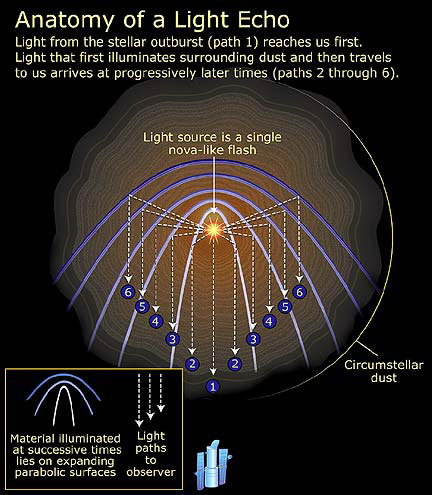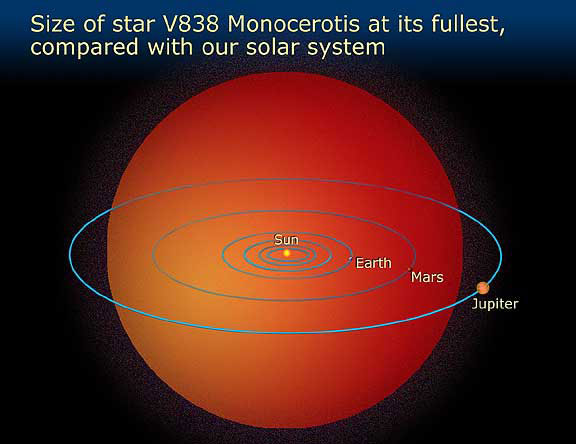|
Embargoed Until: 2 p.m. Eastern
NSF PR 03-32 - March 26, 2003
 Note About
Images
Note About
Images
Photo 1

Light Echo from Star V838 Monocerotis
This sequence of pictures from the NASA Hubble Space Telescope's
Advanced Camera for Surveys dramatically demonstrates the
reverberation of light through space caused by an unusual stellar
outburst in January 2002. A burst of light from the bizarre star
is spreading into space and reflecting off of surrounding shells
of dust to reveal a spectacular, multicolored bull's eye.
This sequence of pictures from May to December 2002 shows apparent
changes in the appearance of the circumstellar dust as different
parts are illuminated sequentially. This effect is called a "light
echo." From the first to last image the apparent diameter of the
nebula appears to balloon from 4 to 7 light-years. This gives the
illusion that the dust is expanding into space faster than the
speed of light. In reality the dust shells are not expanding at
all, but it is simply the light from the stellar flash that is
sweeping out into the nebula. The different colors in the nebula
reflect changes in the color of the star during its outburst.
The red star at the center of the eyeball-like feature is an
unusual erupting supergiant called V838 Monocerotis, located
about 20,000 light-years away in the winter constellation
Monoceros (the Unicorn). During its outburst the star brightened
to more than 600,000 times our Sunís luminosity.
The circular feature has now expanded to slightly larger than the
angular size of Jupiter on the sky. For several more years it will
continue expanding as reflected light arrives from more distant
portions of the nebula. Eventually, when light from the back side
of the nebula begins to arrive, the light echo will give the
illusion of contracting, and finally it will disappear by the end
of this decade. The black gaps around the red star are regions of
space where there are holes in dust. This shows the nebula has a
Swiss-cheese structure.
Credit: PHOTO NO.: STScI-PRC03-10 courtesy of NASA, ESA and H.E. Bond (STScI)
View video: Dissolve sequence of the 4 epochs of the light echo of star V838 Mon. This star was the brightest star in the galaxy for a short time.
http://hubblesite.org/newscenter/archive/2003/10/video/a
Animation Credit: NASA and L. Barranger (STScI)
Photo 2

Caption on image above.
Credit: NASA and A. Feild (STScI)
View video: Light Echo Geometry Cartoon
http://hubblesite.org/newscenter/archive/2003/10/video/c
Animation Credit: NASA and G. Bacon (STScI)
Photo 3

V838 Mon before and during the outburst.
Credit: NASA, USNO, AAO and Z. Levay (STScI)
View video: This animation shows the sudden brightening of the star V838 Mon as it happened on Jan 2002. The star got much brighter because it expanded to a red super giant. In the foreground is a blue companion star.
http://hubblesite.org/newscenter/archive/2003/10/video/b
Animation Credit: NASA and G. Bacon (STScI)
Photo 4

Caption on image above.
Credit: NASA and A. Feild (STScI)
|

